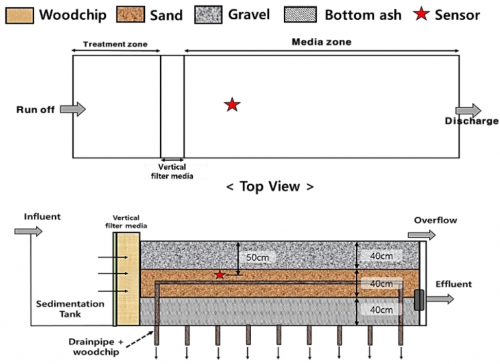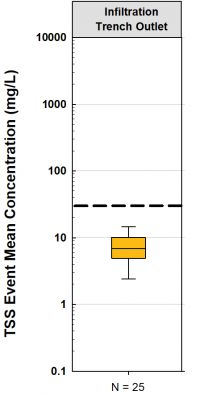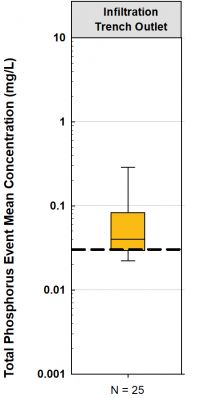Infiltration Trench: Performance
TSS Reduction[edit]
The performance results for Infiltration trench practices, located within TRCA's watershed originate from one site:
- Kortright Centre Parking Lot
The mean performance value recorded at the outlet for the Infiltration trench practice's ability to remove Total Suspended Sediments (TSS) was calculated based on 25 separate recordings from 2013-2014 at the Kortright Centre in Vaughan, ON.
As can be seen in the corresponding boxplot the mean performance removal efficiency of the infiltration trench monitored are well below the suggested guideline of 30 mg/L (Canadian Water Quality Guideline (CWQG), or (background (assumed at <5 mg/L)+ 25 mg/L for short term (<24 hour) exposure) (CCME, 2002[1]; (TRCA, 2021[2]).
The median value of the 25 samples taken was 6.90 mg/L whereas the mean was 7.78 mg/L, with a 0% guideline exceedance.
Phosphorus Reduction[edit]
The performance results for Infiltration trench practices, located within TRCA's watershed originate from one site:
- Kortright Centre Parking Lot
The mean performance value recorded at the outlet for the Infiltration trench practice's ability to remove Total Phosphorus (TP) was calculated based on 25 separate recordings from 2013-2014 at the Kortright Centre in Vaughan, ON.
As can be seen in the corresponding boxplot, the mean performance removal efficiency of the infiltration trench practice monitored is not meeting the acceptable upper extent range of nutrients as it is 0.03 mg/L (30 µg/L) (Environment Canada, 2004[3]; OMOEE, 1994[4]).
The median value of the 25 samples taken was 0.04 mg/L whereas the mean was 0.13 mg/L, with a 76% guideline exceedance. Given the small sample size of just one practice monitored for a year with only 25 grab samples additional infiltration trenches will be required for further monitoring projects to ensure that the results collected are as accurate as possible to ensure these practices can meet federal and provincial governments' guideline requirements for TP stormwater quality.
Please refer to the Phosphorus page and the additives page for more information on how LIDs can reduce contaminant loading in stormwater
Recent Performance Research[edit]
- (Jeon et al., 2022) - Long-Term Monitoring of an Urban Stormwater Infiltration Trench in South Korea
- This paper discusses a long-term monitoring program (8 years) to measure the performance of an infiltration trench and develop a model to be used to estimate influent and effluent stormwater quality based on average removal efficiencies. The study found that the specific trench configuration used (with a primary settling tank with a vertical layer of woodchips, along with horizontal layers of gravel, sand and bottom ash (see associated image to the right on this page). Over the 8-year study (2013 - 2022, in 2017 no monitoring took place due to construction) was able to remove an average of 83% of TSS and 79% of TP (39.31 mg/L & 0.17 mg/L respectively for effluent water quality) (Jeon et al., 2022[5]).

- (Yano et al., 2019) - Comparison of nutrient removal efficiency of an infiltration planter and an infiltration trench
- This study compares the water quality performance of two common LID features (Stormwater planter and infiltration trench to cite advantages and disadvantages of implementing either practice in a parking lot catchment area over a long-term monitoring project (May 2009 to August 2018). The stormwater planter was shown to be more efficient at reducing nutrient content in effluent flow leaving both systems due to additional benefits from plant uptake and larger storage volume when compared to the trench. The study observed removal rates of TP and TSS as 76% and 83% (respectively) for the infiltration trench and 99% and 98.7% (respectively) for the planter (Yano et al., 2019[7]).
- (Nilsson and Stigsson, 2012) - Pollutant removal efficiencies and flow detention of infiltration trenches
- This report highlight the pollutant removal efficiency of an infiltration trench located in supermarket's parking lot in Kungsbacka, Sweden between April to June 2012. The event mean concentration (EMC) over 5 storm events during the study period measured at the inlet and outlet of the trench was 150 mg/L (in) & 21 mg/L (out) for TSS (83% reduction rate). Meanwhile, the concentrations of phosphorus were hardly detectable during the monitoring period, and a removal efficiency could not be measure effectively (Nilsson and Stigsson, 2012[8]).
References[edit]
- ↑ Canadian Council of Ministers of the Environment (CCME). 2002. Canadian water quality guidelines for the protection of aquatic life: Total particulate matter. In: Canadian Environmental Quality Guidelines, Canadian Council of Ministers of the Environment, Winnipeg
- ↑ TRCA. 2021. Spatial Patterns (2016-2020) and Temporal Trends (1966-2020) in Stream Water Quality across TRCA’s Jurisdiction Prepared by Watershed Planning and Ecosystem Science. https://trcaca.s3.ca-central-1.amazonaws.com/app/uploads/2021/10/29113334/2016-2020-SWQ-Report-v11_FINAL_AODA-FA.pdf
- ↑ Environment Canada. (2004). Canadian guidance framework for the management of phosphorus in freshwater systems. Ecosystem Health: Science‐based solutions report no. 1–8. Cat. No. En1–34/8–2004E.
- ↑ Ontario Ministry of Environment and Energy (OMOEE), 1994. Policies, Guidelines and Provincial Water Quality Objectives of the Ministry of Environment and Energy. Queen’s Printer for Ontario. Toronto, ON.
- ↑ Jeon, M., Guerra, H.B., Choi, H. and Kim, L.H. 2022. Long-Term Monitoring of an Urban Stormwater Infiltration Trench in South Korea with Assessment Using the Analytic Hierarchy Process. Water, 14(21), p.3529.
- ↑ Jeon, M., Guerra, H.B., Choi, H. and Kim, L.H., 2022. Long-Term Monitoring of an Urban Stormwater Infiltration Trench in South Korea with Assessment Using the Analytic Hierarchy Process. Water, 14(21), p.3529.
- ↑ Yano, K.A.V., Geronimo, F.K.F., Reyes, N.J.D.G., Jeon, M. and Kim, L. 2019. Comparison of nutrient removal efficiency of an infiltration planter and an infiltration trench. Journal of Wetlands Research, 21(4), pp.384-391.
- ↑ Nilsson, E. and Stigsson, A., 2012. Pollutant removal efficiencies and flow detention of infiltration trenches.

